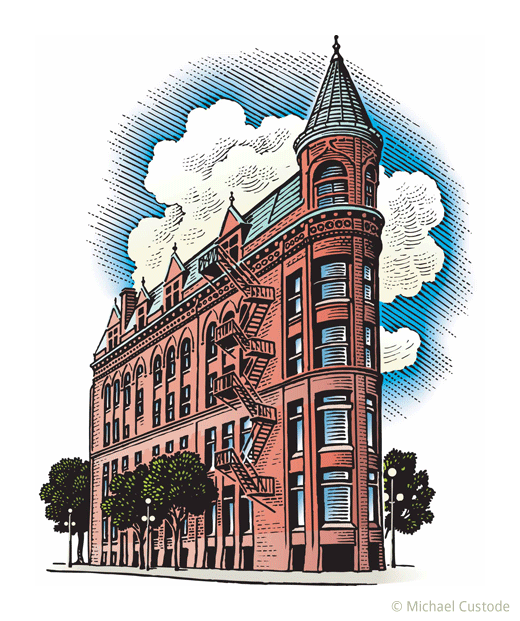Find Your Way: Explore Access Points and Organize Your Visit.
Find Your Way: Explore Access Points and Organize Your Visit.
Blog Article
Uncover the Rich Background Behind the Gooderham Building in Toronto
The Gooderham Structure, an excellent manifestation of Richardsonian Romanesque architecture in Toronto, has a storied past that expands beyond its striking red block frontage. Appointed by the influential Gooderham and Worts distillery in 1891, this building has actually played a critical role fit the metropolitan landscape of the St. Lawrence Market area. As we explore its beginnings, architectural significance, and cultural influence, one can not assist yet question exactly how this spots continues to affect Toronto's identity and heritage. What secrets exist within its walls that contribute to its enduring heritage?

Beginnings of the Gooderham Structure
Constructing a lasting heritage, the Gooderham Structure, also understood as the Flatiron Building, became a sign of Toronto's architectural advancement in the late 19th century. The building's origins map back to 1891 when it was appointed by the Gooderham and Worts distillery, one of copyright's biggest distilling business. Designed by architect David Roberts Jr. Gooderham Building address., the structure was distinctly placed at the junction of Front and Wellington Streets, making the most of a triangular lot developed by the convergence of these highways
The building's construction made use of neighborhood red brick and terracotta, developing a distinct visual that complemented the growing cityscape. Originally intended to house the Gooderham and Worts offices, the building stood for the prosperity of the distillery, which had actually come to be a significant factor to Toronto's economic situation. Especially, the conclusion of the Gooderham Building coincided with a duration of fast urbanization that defined the age.
The establishment of this building gem not just showcased ingenious layout however additionally prepared for future growths in Toronto. Today, it stands as a testament to the city's rich background and versatility, continuing to bring in visitors and admirers from around the world.
Architectural Relevance
The building value of the Gooderham Structure prolongs past its distinct flatiron shape, mirroring the cutting-edge spirit of late 19th-century design. Completed in 1892, the structure exemplifies the Richardsonian Romanesque style, defined by its robust masonry, rounded arches, and complex outlining. The vibrant use contrasting materials, specifically the cozy red brick and sedimentary rock accents, enhances its visual appeal and shows the craftsmanship of the period.
The building's three-story design is significant for its unified percentages and classy cornice, which contribute to its legendary shape versus the Toronto sky line. The slim lot on which it stands posed special challenges, yet the designers, in this case, designed a structure that made the most of the available area while maintaining aesthetic balance.
Furthermore, the Gooderham Building is a testimony to the flexibility of building style in urban settings. Its long-lasting existence in the middle of modern growths highlights the worth of preserving historic style as a way of honoring a city's past. Today, it continues to be a precious site, reflecting both the building fads of its time and the advancing narrative of Toronto as a dynamic urban facility.
Function in Toronto's Development
Arising as a crucial player in Toronto's metropolitan landscape, the Gooderham Structure contributed dramatically to the city's development throughout the late 19th century. The structure was initially created to offer as a stockroom for the Gooderham and Worts distillery, which was one of the largest distilleries in the British Realm.
As the city broadened, the Gooderham Structure became an essential component of the St. Lawrence Market area, which was a hub of profession and business. Its unique building style and popular visibility drew attention, affecting the design of succeeding structures click reference around. In addition, the structure's survival through different financial changes and urban growths reflects the durability and versatility of Toronto's historic landscape. Fundamentally, the Gooderham Building is not simply a building spots; it played a pivotal role fit Toronto's identity and economic growth throughout a transformative duration in its background.
Cultural Impact and Tradition
Gooderham Building's unique architectural style and historical value have actually left an indelible mark on Toronto's social landscape. As one of the city's most recognizable sites, its special flatiron form and detailed brickwork exhibit the Victorian building trends of the late 19th century. This structure not just works as an aesthetic anchor in the St. Lawrence neighborhood but likewise symbolizes the spirit of a growing city during an era of financial development.
The building has become a symbol of Toronto's rich history, motivating local artists and digital photographers that look for to record its appeal. Its presence has actually fostered a feeling of community identification, adding to the story of metropolitan growth. In addition, the Gooderham Building has actually played a critical duty in the tourism sector, drawing in visitors excited to explore its storied past and building charm.
In enhancement to its visual appeal, the structure encapsulates a narrative of strength and adaptation, as it has transitioned via various usages over the years - Gooderham Building address. Therefore, the Gooderham Structure stands not only as a monolith of building relevance but also as a testimony to the advancing social heritage of Toronto

Reconstruction and Conservation Initiatives
Many remediation and conservation initiatives have actually been carried out to guarantee the Gooderham Structure continues to be an important part of Toronto's building heritage. Initially completed in 1892, the structure has actually gone through significant remodellings to address architectural issues while keeping its historic honesty. The most notable repair happened in the late 20th century when the structure was thoroughly refurbished to fulfill contemporary safety criteria without jeopardizing its initial style components.
These initiatives included fixing the unique red-brick façade, restoring the renowned triangular form, and protecting the intricate stonework details. Furthermore, the building's interior has seen cautious updates that respect its historical value, making sure that original functions such as wood beam of lights and decorative moldings are preserved.
The Gooderham Building is now shielded as an assigned heritage property under the Ontario Heritage Act, which assists secure it from unsuitable changes. Community interaction has actually played an important duty in these conservation efforts, with regional campaigning for teams raising understanding concerning the structure's historical value. Consequently, the Gooderham Building stands not only as a useful space yet also as a testimony to Toronto's abundant building history and sustaining cultural tradition.
Final Thought

Please visit one of our local supporters - Gamerama And The Repair Store - Toronto Iphone Repair
Report this page